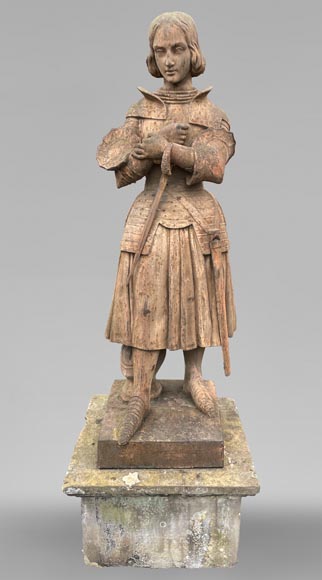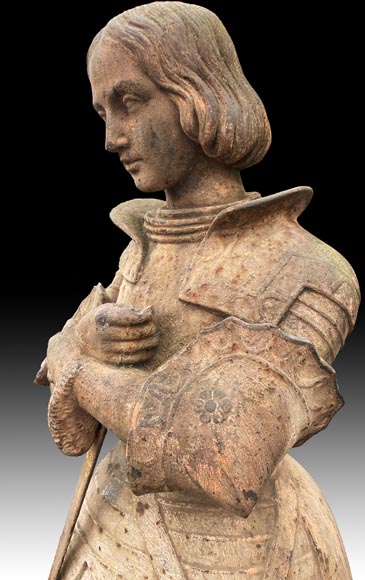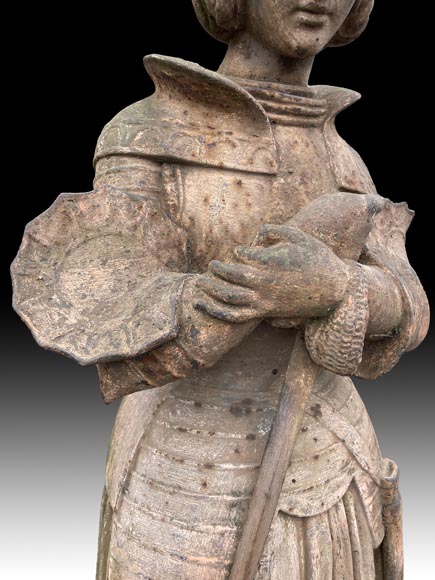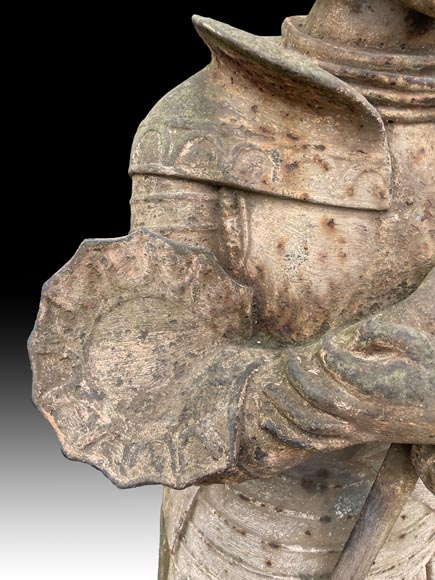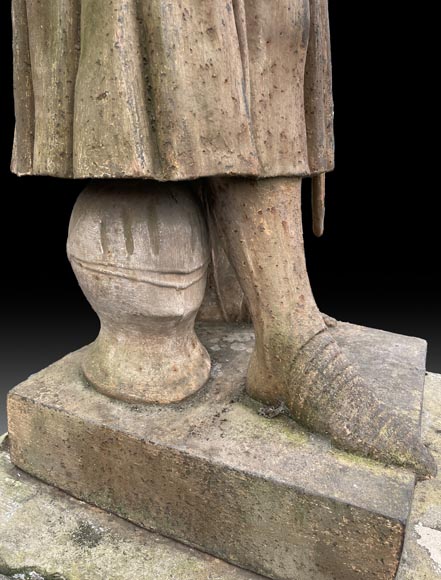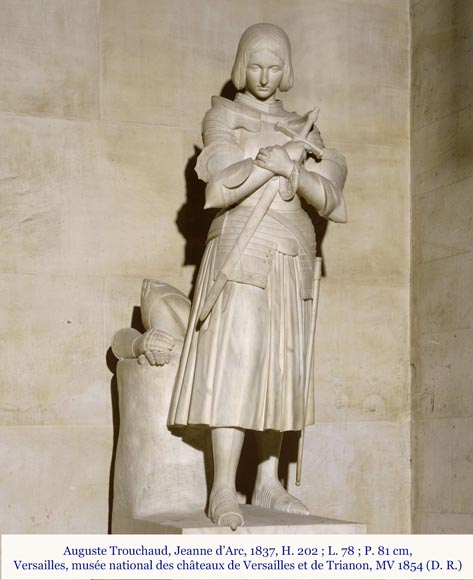Style Other / Ref.15204
Marie d'ORLÉANS (after), Statue of Joan of Arc in cast iron, after 1837
Dimensions
Width 23'' ⅝ 60cm
Height 67'' ¾ 172cm
Depth: 22'' ½ 57cm
Origin:
France, 19th century
Status:
Good condition
This cast iron statue was executed from a model by Marie d’Orléans (1813-1839). The original marble statue created from this model was sculpted in 1837 by Auguste Trouchaud, her designated practitioner, based on the model of the princess of royal blood, commissioned by the King of the French, Louis-Philippe, for the Historical Galleries of Versailles.
Princess Marie d’Orléans (1813-1839), daughter of Louis-Philippe, had a keen interest in art. She was a passionate amateur of the neo-Gothic taste, which was very popular at the time. She studied painting under Ary Scheffer and sculpture under David d’Angers and was herself a talented artist, with a sensitivity close to the Romantic movement. The painting depicting her in her “Gothic salon” shows her literary culture, her taste for Gothic and neo-Gothic furniture, and her artistic practice, with works of her own creation. The young woman died prematurely of tuberculosis shortly after her marriage, which had made her Duchess of Württemberg.
When Louis-Philippe decided to transform the Palace of Versailles into a museum dedicated “to all the glories of France,” he commissioned his daughter to create a statue of Joan of Arc to populate his new Historical Galleries. However, while Marie d’Orléans sculpted, she did not master marble carving, which explains the involvement of another sculptor for the creation of the final statue.
The reviews were unanimously laudatory. They recognized the young artist’s talent and praised her dedication. The subject indeed inspired Marie d’Orléans: she had a genuine admiration for Joan of Arc, whose iconography experienced a strong resurgence under the Restoration and at the beginning of the July Monarchy following various rehabilitation efforts. This figure emerged in connection with the “national novel” then widely constructed and disseminated, although Joan’s canonization only occurred later, in 1920.
Joan of Arc is depicted full-length, in armor, with a serene face. Despite her martial attire, she remains feminine: with medium-length hair, a gentle face, she wears a mid-length skirt extending from the armor at the waist. She holds a sword drawn from its scabbard but not brandished, held against her in a meditative and almost peaceful posture, her arms crossed over her chest in a sign of contemplation. Her helmet and gauntlets are placed beside her. In a concern for historical accuracy, Marie borrowed a 15th-century armor from the Artillery Museum to precisely replicate its form. On the original model, the handle and guard of the sword evoke the Cross of Calvary.
The 19th century marks the beginning of the golden age of reproducibility, notably in the field of statuary. The statue of Joan of Arc was no exception, and several versions exist. In 1840, a bronze statue was commissioned by Louis-Philippe from the founders Louis Soyer and Étienne Ingé, and offered to the city of Orléans in gratitude for the condolences expressed by the city following the death of his daughter in 1839. This model is very close, although not identical: unlike the original statue, the accessories are placed on a pedestal at mid-height. The statue is now housed in the Hôtel Groslot in Orléans.
After his daughter’s death and to honor her, Louis-Philippe also had Auguste Trouchaud execute a marble bust version of the statue for the Tuileries Palace. The choice of the bust emphasizes the young woman’s very contemplative attitude and the great delicacy of the sculpture. The bust is now located in the Museum of Fine Arts in the city of Orléans.
A bronze model of this work was presented at the Exposition of Industrial Products of 1839 by the Susse Foundry. A commentary from the Exposition mentioning the statuette in question highlights the renown of Marie d’Orléans’ work: “Who does not know the Joan of Arc by Princess Marie?” (no. 22). It further notes: “Among these works, we who carefully choose those most worthy of admiration and publicity could not leave aside the Joan of Arc”; the one closest to the original being made by the Susse Foundry, based on a model executed by “Mr. Jacquemart”.
Informations
Price: on request
Recommended for you :
Dimensions:
Width: 64
Height: 274
Depth: 64
Dimensions:
Width: 49
Height: 89
Depth: 88
Dimensions:
Width: 66
Height: 161
Depth: 50
Diameter: 50
Dimensions:
Height: 128
Depth: 79
Diameter: 55
Dimensions:
Height: 238
Diameter: 75
Dimensions:
Height: 265
Diameter: 100
Dimensions:
Width: 107
Height: 224
Depth: 121
Dimensions:
Width: 56
Height: 118
Dimensions:
Width: 64
Height: 162
Dimensions:
Width: 66
Height: 159
Depth: 64
Dimensions:
Width: 36
Height: 56
Depth: 36
Dimensions:
Height: 117
Diameter: 135



